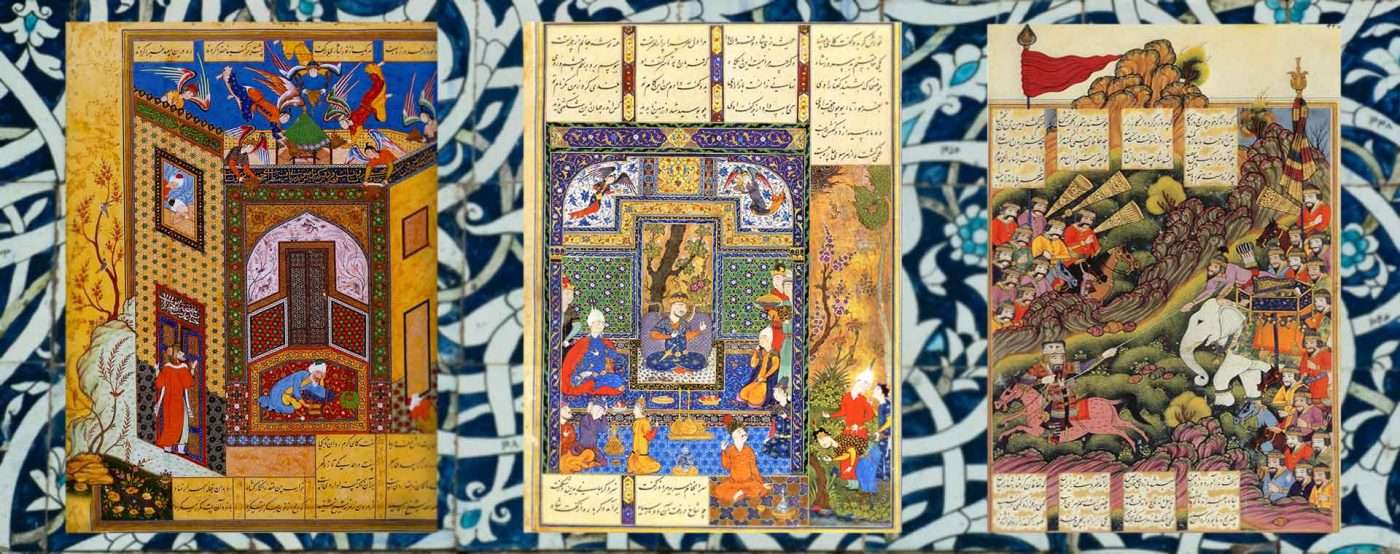
Themes in Persian Literature
Contents
History and Myths
Due to the religious background of the literature in pre-Islamic Iran and the intermingling of ancient Persian myths with Zoroastrianism and also its fusion with the religious Sassanid government history and myth writing has deep roots in Persian literature.
In the New Persian language which separated from the Middle Persian after Islam writing literal history and myths have been done repeatedly. The historical Prose and mythology texts which do not have literal aspects, the language used, and using literary arrays have put them in the category of literary works. We can refer to books such as Bal’ami History, Beyhaqi History, Tabarestan History, Tarikh al-Rosol val Moluk, Mojmal al-Tavarikh.
Shahnameh of Ferdowsi is the most prominent work among the works of verse that had been composed as poems. This epic work contains the legends of Zoroastrian Iran and even the Pre-Zoroastrian period and in this work, Ferdowsi tried to save them from oblivion under the impact of religious beliefs. The contents reflected in Shahnameh are somehow different from the original version and Ferdowsi besides having the knowledge of the original story which existed in the verse books has changed them in a way that they do not fall under the category of forgotten works.
The story of Keyumars which even in Islamic sources has been referred to as superhuman has changed to the first king and the story of Mashya and Mashyana and the dualism in Zoroastrian religion that wasn’t in accordance with the time of Ferdowsi had been removed from the work.
Besides Ferdowsi, we can name some history and legend writing poets like Daqiqi, Asadi Tusi, Khwaju Kermani, and Zartosht Bahram-e Pazhdo.
Mysticism
Mysticism and mystical instructions have a special place in classic Persian literature. The history of the tendency to mysticism in Persian literature goes back to Mani and Manichaeist teachings. In the post-Islamic period, a lot of Iranian literati and poets also started to create literary works with mystical themes. Among them, we can refer to Abu Saeed Abul Khair as one of the pioneers. But the entering of mysticism into Persian literature officially goes back to the spiritual sonnets of Sanai. Later, after the progress of Iraqi style in poetry, it was intermingled with mysticism in a way that many mystical perceptions and terms entered the common poems of that era.
One of the most important reasons for the tendency to mystical poetry is the literary taste of Sufis and the followers of Sufism. Many famous Sufis of Iran had Diwan and poetry books and were known as the prominent poets of their period. Hence, Sufi poetry, which is also one of the branches of Islamic mysticism found its way to the common literature of Iran, especially after the Mongol invasion.
Among the most famous poets who wrote Sufi and spiritual poems, we can name Baba Tahir, Jami, Hatef Esfahani, Fakhr-al-Din Iraqi, Shah Nimatullah Wali, Rumi, Attar of Nishapur, Mahmoud Shabestari, and Fayz Kashani. Also, we can name some of the literary mystical prose writers like Ayn al-Quzat Hamadani, Khwaja Abdullah Ansari, Shams Tabrizi, Sheikh Ahmad Jami, Mohammad Ghazali, and Sad al-Din Nizari Quhistani.
Among the important mystical works of Persian literature we can name Masnavi by Rumi, Diwan of Shams by Rumi, The Conference of the Birds by Attar, Monajat Nameh by Ansari, The Alchemy of Happiness by Ghazali, Kashf al-Mahjub by Hujwiri.
Romantic Subjects
The fondness of romantic subjects in Persian literature goes back to the early period of formation the of Persian literature. We can see a lot of romantic meanings in the works of earlier poets such as Kisai Marvazi, Rudaki, and Unsuri. In the same period inside the great and everlasting work of Ferdowsi which is Shahnameh romantic stories like Bijan and Manijeh, Khosrow and Shirin, and Zaal and Rudabeh all talk about the human aspect of love.
In the following period in which poets like Nezami, Anwari, Khaqani, Fakhruddin As’ad Gurgani manifested writing romantic sonnets and writing fictional romantic poems increased. In the same period in addition to the entering of mystical contexts to the literature by Sanai Qaznavi, a sort of celestial love which is the love of God entered Persian poems. However, in the times in which Saadi and Hafez were the heads the concept of love came to a level between earthly and celestial love and it is important to say that Persian literature has many love stories.
Elegy and Panegyric
A big part of Persian literature consists of elegy and panegyric. Elegy is said to a poem that is written or recited for personal grief and panegyric is said to a poem that is wrote to praise or hail a specific person, be it alive or related to the past. The style in this type is usually Qasideh; however, you can see praise in other styles such as Masnavi and Sonnet (Ghazal).
The subjects of the praise are usually the elders of religion, kings, and influential courtiers. The poets of the court lived especially in Samanid and Ghaznavid periods which among them we can name Unsuri, Asjadi, Farrukhi Sistani, Manuchehri, and Masud Sa’d Salman. Although other poets such as Rudaki have written praise poems before in the court of Samanids. But the difference between Rudaki and these poets is that in Rudaki poems, more than seeing praise, you can see stories and opinions and sometimes with respect to the king or an elder, their names in the last few verses of the poem.
This sort of saying praise which later was known by the famous sonnet writers such as Hafez, Saif Farghani, and Khwaju Kermani more than being praise it was a poem which sometimes mentioned the name of the elders, although the context of the poem might not be related.
In Masnavis in the poems of Ferdowsi, Nezami, and Fakhruddin As’ad Gurgani the collection of poems with verses praising one of the elders was written under his name and given to that person. Among the poets which were active in the field of panegyric literature, we can mention Anvari, Khaqani, Mu’izzi of Nishapur, and Kamal od-Din Esmail.
After the establishments of the Safavid Empire in Iran, the interest in panegyric writing decreased and the panegyric poets mostly immigrated to India and the Ottoman territories. During this period religious praise became popular which Muhtasham Kashani is counted as one of the most important panegyric poem writers of this period.
Kisai Marvazi is known as the first religious praise writer in the history of Persian literature. Baba Tahir, Khayyam, and Nasir Khusraw are poets which have never praised anyone.
Ethics and Wisdom
The subject of morality is one of the oldest themes in Persian literature. In many Pahlavi texts especially in Andarznameh which goes back to the latest periods of the Sassanid dynasty and is written under the impact of Avestan texts “ethics” are the main subject. Among these writings, we can name Menog-i Khrad and the religious book of Shayest ne Shayest.
In Dari dialect of the Persian language moral issues are presented in the poems of many poets and a lot of prose texts have been written in this field. Among them, we can mention Nasirean Ethics, Gulistan of Sa’di, Qabus Nameh, Diwan of Parvin E’tesami.
Biography, Comedy, and Memoir writings are some of the other themes in Persian literature.
